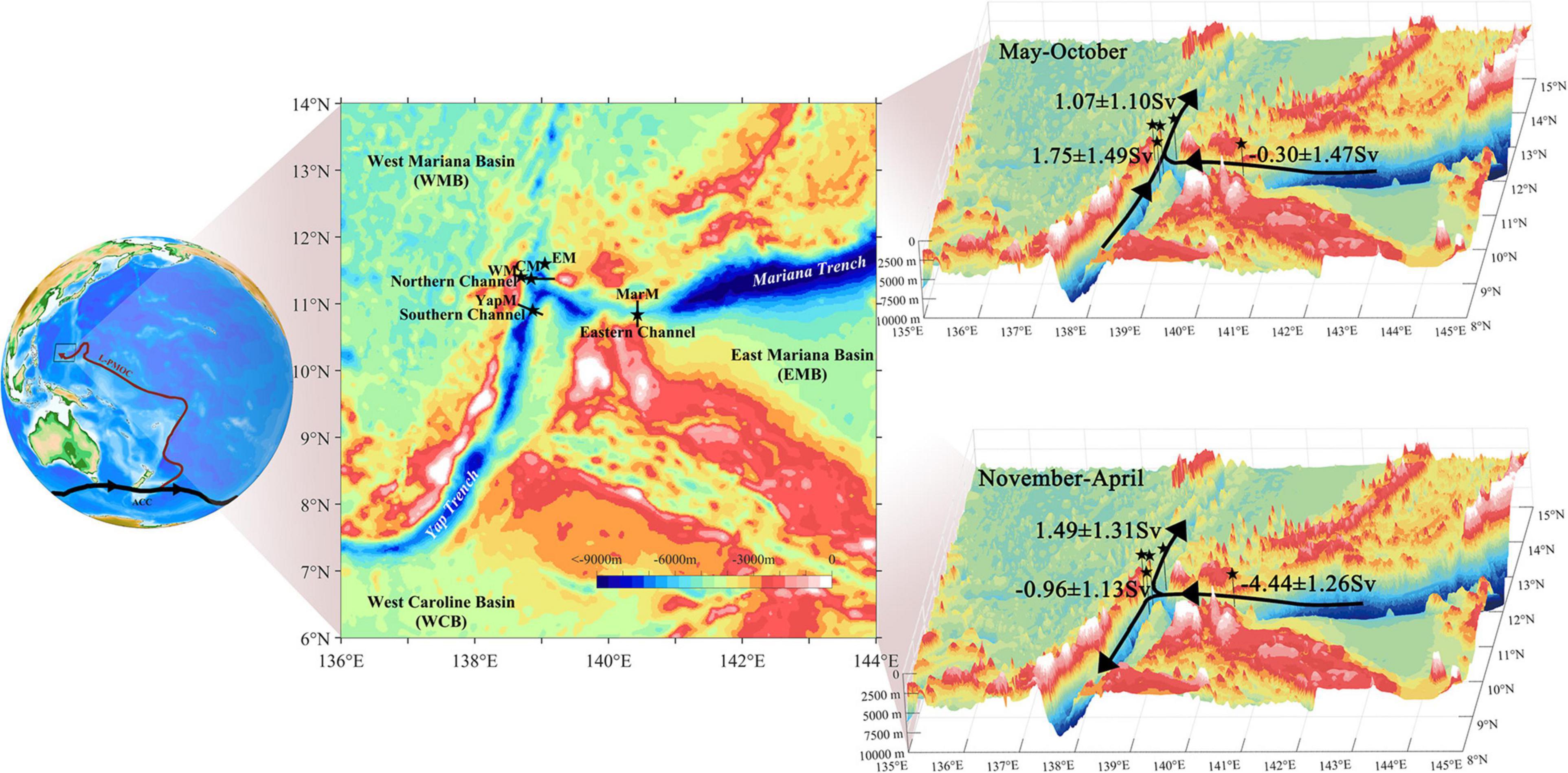Pathways, Volume Transport, and Seasonal Variability of the Lower Deep Limb of the Pacific Meridional Overturning Circulation at the Yap-Mariana Junction
Jianing Wang, Fan Wang*, Youyu Lu, Qiang Ma, Larry J. Pratt and Zhixiang Zhang
Published in Frontiers in Marine Science
The lower deep branch of the Pacific Meridional Overturning Circulation (L-PMOC) is responsible for the deep-water transport from Antarctic to the North Pacific and is a key ingredient in the regulation of global climate through its influence on the storage and residence time of heat and carbon. At the Pacific Yap-Mariana Junction (YMJ), a major gateway for deep-water flowing into the Western Pacific Ocean, we deployed five moorings from 2018 to 2019 in the Eastern, Southern, and Northern Channels in order to explore the pathways and variability of L-PMOC. We have identified three main patterns for L-PMOC pathways. In Pattern 1, the L-PMOC intrudes into the YMJ from the East Mariana Basin (EMB) through the Eastern Channel and then flows northward into the West Mariana Basin (WMB) through the Northern Channel and southward into the West Caroline Basin (WCB) through the Southern Channel. In Pattern 2, the L-PMOC intrudes into the YMJ from both the WCB and the EMB and then flows into the WMB. In Pattern 3, the L-PMOC comes from the WCB and then flows into the EMB and WMB. The volume transports of L-PMOC through the Eastern, Southern, and Northern Channels all exhibit seasonality. During November–April (May–October), the flow pathway conforms to Pattern 1 (Patterns 2 and 3), and the mean and standard deviation of L-PMOC transports are −4.44 ± 1.26 (−0.30 ± 1.47), −0.96 ± 1.13 (1.75 ± 1.49), and 1.49 ± 1.31 (1.07 ± 1.10) Sv in the Eastern, Southern, and Northern Channels, respectively. Further analysis of numerical ocean modeling results demonstrates that L-PMOC transport at the YMJ is forced by a deep pressure gradient between two adjacent basins, which is mainly determined by the sea surface height (SSH) and water masses in the upper 2,000-m layer. The seasonal variability of L-PMOC transport is attributed to local Ekman pumping and westward-propagating Rossby waves. The L-PMOC transport greater than 3,500 m is closely linked to the wind forcing and the upper ocean processes.

Figure. (Left) Schematic flow pattern of lower deep branch of the Pacific Meridional Overturning Circulation (L-PMOC) from the Antarctic Circumpolar Current (ACC) to the western Pacific (after Siedler et al., 2004; Kawabe and Fujio, 2010). (Middle) Map of topography near the Yap-Mariana Junction showing locations of five moorings MarM, YapM, WM, CM, and EM (stars) and the cross sections of Eastern, Southern, and Northern Channels (lines). (Right) The seasonal pathways (arrows) and volume transports (numbers: mean ± standard deviation) of the L-PMOC during (right upper) May–October and (right lower) November–April are given based on the present study. Stars denote the mooring locations. The bathymetry is from ETOPO1.
Wang J., F. Wang*, Y. Lu, Q. Ma, L. Pratt and Z. Zhang, 2021. Pathways, Volume Transport, and Seasonal Variability of the Lower Deep Limb of the Pacific Meridional Overturning Circulation at the Yap-Mariana Junction. Frontiers in Marine Science 8, https://doi.org/10.3389/fmars.2021.672199